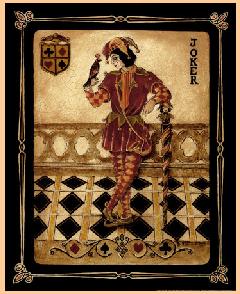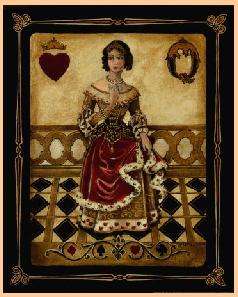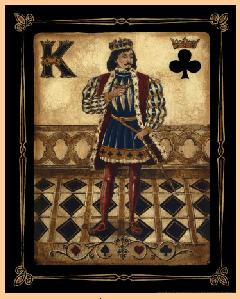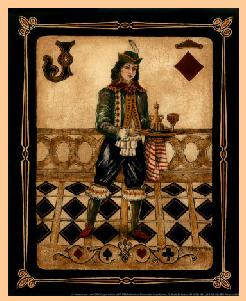
Candida Martinelli's Italophile Site

Main
Page This family-friendly site celebrates Italian culture for the enjoyment of children and
adults. Site-Overview
The Vegas
Guy explains that many of the popular betting card games are not
offered at today's casinos because in an honest game, the payouts of
2 to1 are too low for the casino to make much money. "Some
of the games of chance you will not find in Las
Vegas, for example, are faro, monte, lansquenette, Rouge et Noir, rondo,
Chinese Fan-tan, Red White and Blue, Diana, and ziginette, all of
which are legal, all of which are specifically authorized by statute,
and many of which are still played in foreign gambling halls." The games were very popular when travelling 'houses' set up games,
took money with crooked dealing boxes, had reliable shills to make the
game look on the up-and-up, and skipped town before anyone was the
wiser. Wyatt Earp ran Faro games, when he wasn't involved in shoot-outs. The
Vegas Guy further explains that all those games he mentioned,
including Ziginette, are variations of the once very popular
bank/betting game Faro. "Evidence
of just how popular Faro became can be seen in the various ethnic
versions of it.
On New York's Lower East Side, they played "Stuss,"
or Jewish Faro.
In Italy, they played--and still play--ziginette.
The slaves and descendants of slaves played
a game that was so simple it could be set up on any sidewalk, and it was
called "skin."
Hispanics played Spanish Monte. Asians
played Chinese Fan-Tan.
The most primitive of all versions of
faro, which occasionally makes a comeback in the casinos, is a sucker
game called Red Dog. It was played by World War II soldiers and, alas,
by newspapermen. The most complicated faro game I ever saw is "Rouge et Noir," also
called "Trente et Quarante," which is played at the Casino Monte-Carlo
in Monaco. The game uses a special table with complicated diagrams on
it, 312 cards in a six-deck shuffle, and requires five croupiers to keep
track of the play. I watched it for an hour and I still have no idea how
it works."
A site visitor, Mark H., contacted me a while
back asking if I knew of a card game he remembered from his
childhood in Buffalo, New York. He recalled
Italian-Americans playing the game, especially Sicilian-Americans.
They called it "Ziginat".
I'm afraid I wasn't much help, so he kept
researching it with 'some characters from my youth', as he
says, and his friend and barber, Sam, a native of Italy.
He discovered that... 'Apparently the game has a lot of different
names in different places, but regardless of whether it's played in
a casino in France or on a blanket in a saloon in Buffalo, I don't
advise getting into it unless you've got big bucks, for as Sam
says, you can get hit like with a bomba. 'He knew it under the title of "Tagliare,"
but the Sicilians in Buffalo called it Ziginat, not too
different from the French name, Ziginette. [Tagliare in
Italian means a Trump card, or a winning card, a card that beats all
other cards, as in this case, the dealer's card.]
It seems to be a popular
betting game with Italian-Americans throughout the States.
An
Italian blogger says the game, originally Zecchinetta,
is Norman (French) and came to Italy with the Normans. The Normans invaded and occupied Sicily. That might
explain why it is so popular with Sicilian-Americans, and why
they use a name similar to the French name. He also notes that some American game sites report that it is
a popular Italian card game, but the game appears in none of the
recent Italian books on card games. It seems the game has
fallen out of use in Italy, while descendents of Italian
immigrants carry on the tradition of their ancestors. An
Italian games site has the rules in Italian, and says in
Central Italy, where it can still be found, it is still called
Zecchinetta. The name comes from the
mercenary soldiers,
Lanzichenecco,
who played it when they came to Italy, working under
contract to the Normans. Oddly, the Italian verb, azeccare, means to guess
correctly, or to divine something, and certainly sounds like it
comes from Zecchinetta, where the player tries to divine
the next card to be exposed. 'Matched cards' are removed from the game as the deal
progresses. The game/deal ends when the 'dealer's card' is matched. The deal rotates among the players. The payout is 2 to 1 (you double your bet) The rules in greater detail appear below.
1) One standard 52-card deck from which all the 8s, 9s, and l0s
have been removed, leaving 40 cards. Two or more people can play. One person is banker. There are also
two house officials. One, the cutter, collects and pays bets
for the banker, and takes the house's percentage cut. (The house
never banks the game.) The other, the lookout, keeps a watch
on proceedings, and transfers dead cards to the discard pile. The objective is for a player to bet on a table card that is not
matched before the banker's card has been matched. A card is
matched, when another card of the same denomination becomes
visible at the top of the card box. Choice of first banker is by deal — the first ace to appear. The
cutter carries out the deal after he has shuffled the cards,
and had them cut by any player. Any player, other than the banker, cuts the cards. The banker
places the deck face up in the card box. The banker deals two cards from the box face up onto the table.
The next card in the box is now visible; this is the banker's card.
If all three cards are of different denominations, players may now
bet. If they are not, special rules govem further procedure (see the
section on playette). Any player, other than the banker, may place a bet on one or both
of the table cards. The banker decides the minimum and maximum allowable bets, and
can alter them at will between stages of play. The banker takes the banker's card from the box, and places it so
that one end rests beneath the card box, but most of it is visible.
It stays in this position for the rest of the deal. This exposes the
next card in the box. If the card now exposed matches any card on
the table (including the banker's card), any bets involved are
settled. But if it does not match any card on the table, there is no
further action in this turn, unless any player wishes to place a
further bet. If at any time a card exposed in the box matches the banker's
card, the banker loses all unsettled bets, i.e., he pays all
outstanding bets by players on all table cards. Settlement is at
even money — a winning player gets back his stake plus an equal
amount from the bank. Play on this deal then ceases, and the bank
and deck pass one player to the right. If a card exposed in the box
matches a table card on which bets have been placed, these bets are
won by the banker, and he continues to operate the bank The house
cutter pays out the banker's losses, and collects his winnings
for him. He takes a l0% house cut from each bet won by the bank. If the banker's card has not been matched, then any settlement of
bets, and placing of new bets, ends the turn of play. The exposed
card is then taken from the card box. 1) If the exposed card has matched a table card, then the exposed
card and the table card it matched are now dead (even if the table
card had no bets placed on it). The cutter takes both cards, and places them to one side,
out of play. They are dead for the remainder of the deal, as are the
other two cards of the same denomination still in the card box. When
cards appear in the box that are the same denomination as cards
already matched, they are removed and added to the discard pile. The
discard pile is kept fanned out, so that the denominations of dead
cards can be seen. 2) If the exposed card has not matched a table card, then it is
placed face up on the table, alongside the other table cards. It is
now available for players to bet on in the usual way at the end of a
turn of play, provided that it is not matched immediately by the new
exposed card in the box. If it is matched immediately, both it and
the matching card are transferred to the discard pile in the usual
way, and the other cards of the same denomination are also dead. Play continues in this way until the banker's card is matched. At
each turn of play: 1) The top card is removed from the card box. 2) If, on the previous turn, it had matched a table card, it is
placed on the discard pile together with the card it matched. If it
was the same denomination as a card already matched, it is added to
the discard pile. If it had matched neither a table card nor a dead
card, it is added to the table cards. 3) If the card now exposed in the box matches a table card, any
bets involved are settled. If it matches the banker's card, the
banker collects all bets, and the deal ends. 4) If the banker's card has not been matched, players can bet on
any card now on the table. This includes any card just added to the
table, provided that this card has not been matched immediately by
the new card exposed in the box. This is the term used, when two cards of the same denomination
appear in the opening deal. It is usually ruled no deal. The
cards are removed from the box, and reshuffled. Sometimes the rule
is that the duplicate cards are doubled up. If two table cards match, they are placed together, and the top
card from the box is dealt to fill the empty table position. If a
table card and the box card match, the box card is added to the
table card's position. In either case, the next card in the box
becomes the banker's card. When any two cards have been doubled up, then, with all
denominations, no bets are settled until three cards of the
denomination have appeared. For example, the bank does not win the
bet on the 6s until a further 6 has been exposed; the bank does not
win the bet on the Queen of Hearts until two further queens have
been exposed; the bank does not lose until two further l0s have been
exposed. If all three cards of the opening deal are of the same
denomination, then (provided that doubling up is allowed),
they are all placed together on one of the table hand positions. No
decision is reached on any bet, nor on the bank, until four cards of
a denomination have been exposed. A banker may pass the bank at any time when there are no
unsettled bets on the table. When the banker's card is matched, he
must pass the bank. All cards are collected, shuffled, and cut,
before the new game begins. From the
Games Forum who sourced it: From 'The Official World Encyclopedia of Sports and Games'

Ziginette
- Zecchinetta, a card game
![]()




A Childhood Memory

Zecchinetta
Ziginette requires:
Object of the game:

Ziginette - Zecchinetta : a betting game
Equipment
2) A metal card box that allows only one card to be removed at a
time.
© Diagram Visual Information Ltd 1979